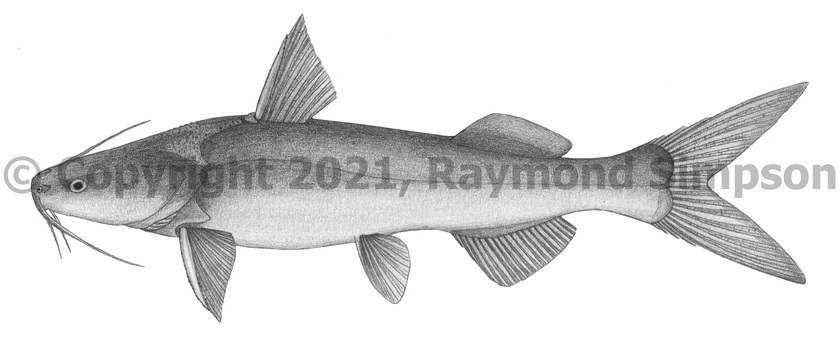
Common Name
Kukwari Sea Catfish
Year Described
Valenciennes, 1840
Identification
Dorsal Fin: I, 7
Anal Fin: 17-20
Pectoral Fin: 10-11 rays
Pelvic Fin: 6
Caudal Fin: 13 branched (6 upper, 7 lower)
Gill Rakers: 12-15 (first arch); 13-16 (second arch)
Vertebrae: 46-47 free
Amphiarius is defined by the combination of the following characters described in Marceniuk & van der Steen (2017): medial fleshy groove absent, a large fenestra between frontal and lateral ethmoid, posterior cranial fontanel well developed, epiooccipital sometimes projecting into dorsal shield, occipital process long and tapering posteriorly, nuchal shield small and crescent-shaped, vomerine tooth patch absent, accessory tooth plates small and rounded, and adipose fin as long as anal fin.
Body elongate and robust with a strongly arched back. Head flattened. Greatest body depth at dorsal fin. Snout broad and squared off. Nostrils not connected by a furrow. Anterior nostril fleshy and posterior covered by a flap. Cephalic shield quite small and moderately rough. Anterior edge of head shield well behind eyes with a distinct anterior indent/depression but no median groove. Supraoccipital process about as long as head shield, narrow, and tapering posteriorly. Nuchal plate small and crescent-shaped. Mouth subterminal. Eye relatively large. There are three pairs of barbels (one maxillary and 2 mental) with the maxillary barbel barely reaching the pectoral fin. A single arched patch of villiform teeth cross maxillary. Vomerine tooth patch absent. Accessory patches small, rounded, and well separated Dorsal fin high with a strong serrated spine. Pectoral fins about the same size as dorsal fin with strong, weakly serrated spines. Pelvic and anal fins located far back on body. Adipose fin as long as anal fin. Caudal fin strongly forked. No rakers on rear of gill arches. Body naked.
Color
Body gray to gray-brown above, grading rapidly to whitish below. Fins uniformly gray.
Size
Maximum size to 30cmTL. Common to 20cm TL.
Habitat
Found mostly in freshwater and brackish estuaries over soft bottoms.
Range
Eastern Venezuela (Orinoco mouth) to northern Brazil (Amazon mouth).
References
Acero, A. 2002. Ariidae (pp 831-852). In: Carpenter. 2002. The living marine resources of the Western Central Atlantic. Vol. 2: Bony fishes part 1 (Acipenseridae-Grammatidae). FAO Species Identification Guides for Fisheries Purposes. American Society of Ichthyologists and Herpetologists Special Publication No. 5.
Marceniuk, A.P. & van der Steen, P. 2017. Family Ariidae. In: van der Sleen, P., & Albert, J.S. (Eds.). 2017. Field guide to the fishes of the Amazon, Orinoco, and Guianas (Vol. 115). Princeton University Press.
Other Notes
The two Atlantic Amphiarius can be distinguished by gill raker and vertebral counts.